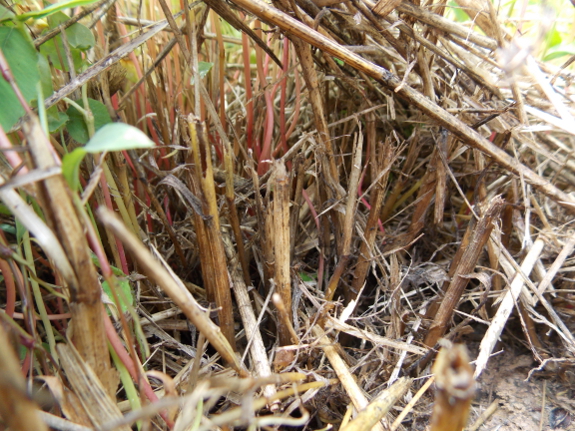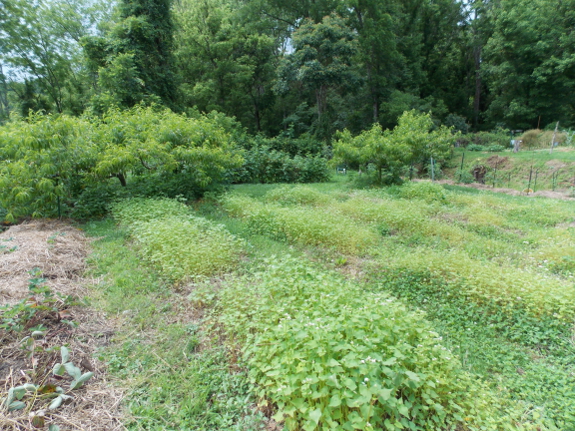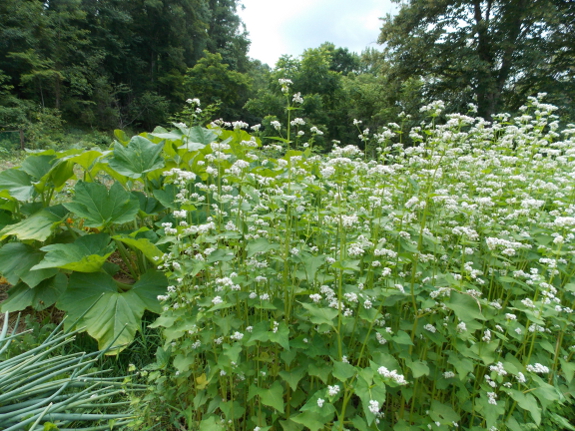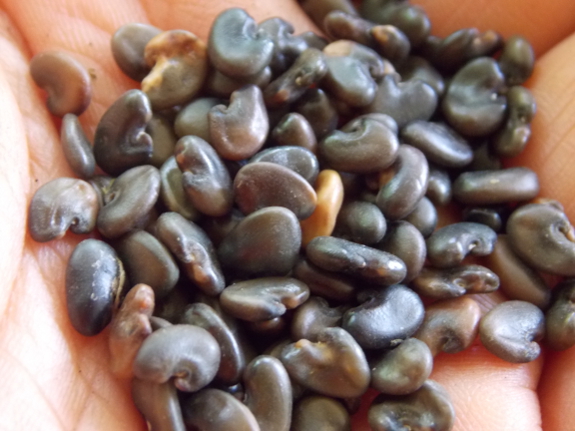
Summer 2013 cover crop experiments

I haven't regaled you
with tales of cover crops in a while, but that
doesn't mean we haven't been experimenting. First of all, cutting
rye with the weedeater right at ground level was highly effective, although my
scything a little higher up resulted in some resprouting.
The plants we cut early, just as they were barely starting to
bloom, were also more likely to resprout. A final warning
--- the rye did hold onto nitrogen much harder than any other
cover crop I've grown, so a few broccoli sets I transplanted
directly into manure poured on top of the stubble took a week or
two to really start getting the nutrients they needed. But,
overall, we were very pleased with our rye experiment and will
definitely repeat it, especially in problematic soil areas where
the rye built masses of organic matter.

Most of the back
garden is fallow this year as I prepare
it for next year's tomato crop, so I broadcast buckwheat seeds into the rye before
Mark cut it. Mark and I both spread our pee on certain areas
for a week or so (until the buckwheat started sprouting) to add
nitrogen to the ground, but the buckwheat is struggling. It
definitely came up well through the rye stubble, but I've always
had a problem getting much growth out of buckwheat in areas with a
very high groundwater, and this year is no exception. We'll
get a bit of growth out of the back garden buckwheat, but I'm
thinking of trying some sunflowers next.

In contrast, the
buckwheat I've planted into good garden areas is over twice as
large and is thriving. I've already made inroads into my buckwheat
challenge,
having planted about 4.5 gallons of seed so far this spring and
summer.

But our big
experiment came into my inbox as a whim. Harvey
Ussery is
testing out sunn hemp (Crotalaria juncea), and wanted to send out
samples to his readers for us to try in different parts of the
country. This legume gets up to eight feet tall and produces
huge amounts of biomass before frosts kill the plants in the
fall. You can cut the plants at 60 days as a high-nitrogen
addition to the garden or compost pile, or wait a bit longer, at
which point the carbon levels rise and sunn hemp becomes a quality
mulch. In addition, cutting the plants once at four feet
tall results in resprouting and even more biomass
production. I slipped the seeds into gaps in the forest
garden where broccoli was coming out, and I envision the
high-carbon stems at the end of the year will make good mulch
around fruit trees. I'll keep you posted about the results
of my experiment, and you'll be able to read how sunn hemp did for
us and other experimenters this fall or winter in an article by
Harvey Ussery in Mother Earth News.
Want more in-depth information? Browse through our books.
Or explore more posts by date or by subject.
About us: Anna Hess and Mark Hamilton spent over a decade living self-sufficiently in the mountains of Virginia before moving north to start over from scratch in the foothills of Ohio. They've experimented with permaculture, no-till gardening, trailersteading, home-based microbusinesses and much more, writing about their adventures in both blogs and books.
Want to be notified when new comments are posted on this page? Click on the RSS button after you add a comment to subscribe to the comment feed, or simply check the box beside "email replies to me" while writing your comment.

I realize you grow mainly for mulch but I am in seriously in need of compost. Is buckwheat considered brown or green? I have enough lawn to produce a couple yards of grass clipping weekly, 50/50 mulch and compost until garden and pathways (as kill mulch) are covered but rapidly running out of stored leaves. I did manage to score two loads of tree mulch from utility contractor for next year. I currently have 3500 sft garden, 1500 sft just put in as chiken pasture and starting 2500 sft forest garden which will hopefully be ready for January planting. Results so far are mixed but I am considering this year as building more than production starting with hardpacked red clay. Any help will be appreciated. You blog has encouraged me to get started on road to food security in a couple years.
Tom --- Sounds like you've got a great operation going! This post will help you out with your question. Even though I'm talking about how soon you can plant into cover crops in that post, C:N also determines how "brown" or "green" a compost pile addition is. An optimal compost pile, when properly mixed, has a C:N of about 30:1, so buckwheat would make its own compost pile with no browns or greens added. You might consider it neutral.
However, one thing to consider when growing cover crops to make compost is that you're going to be mining the soil rather than building the soil in the spots where you grow the cover crops. You'll have to add extra nitrogen and other fertilizer to those spots before planting into them again to make up for what the cover crops took away. That nitrogen, of course, can come from your compost pile...but then you might start wondering why you went to the trouble of moving the buckwheat to a pile and then back to the garden bed! Mini compost piles on the sides of the beds are my solution --- they act like mulch until the plants break down enough for worms to work the debris into the soil as compost.